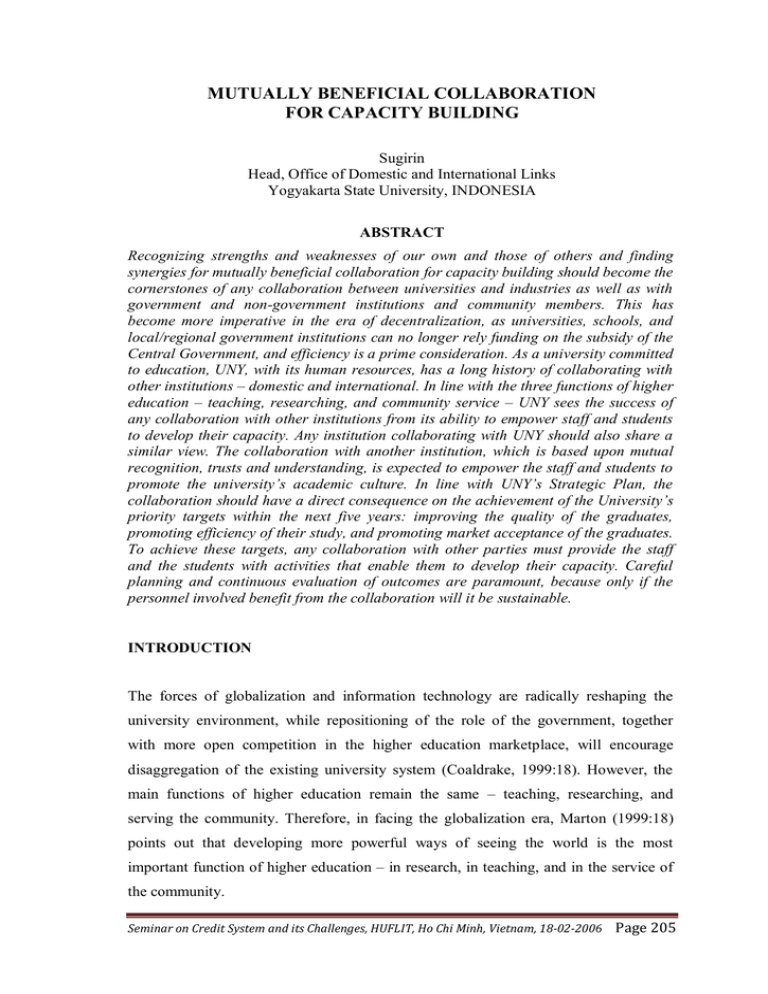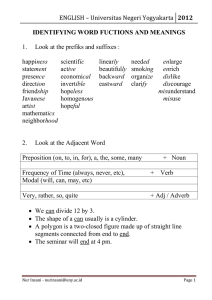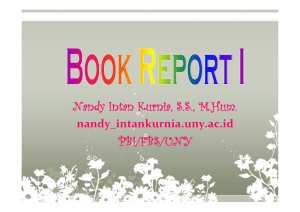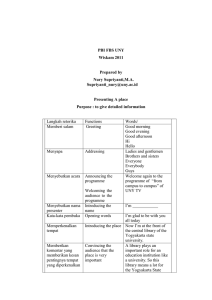MUTUALLY BENEFICIAL COLLABORATION FOR CAPACITY BUILDING
advertisement

MUTUALLY BENEFICIAL COLLABORATION FOR CAPACITY BUILDING Sugirin Head, Office of Domestic and International Links Yogyakarta State University, INDONESIA ABSTRACT Recognizing strengths and weaknesses of our own and those of others and finding synergies for mutually beneficial collaboration for capacity building should become the cornerstones of any collaboration between universities and industries as well as with government and non-government institutions and community members. This has become more imperative in the era of decentralization, as universities, schools, and local/regional government institutions can no longer rely funding on the subsidy of the Central Government, and efficiency is a prime consideration. As a university committed to education, UNY, with its human resources, has a long history of collaborating with other institutions – domestic and international. In line with the three functions of higher education – teaching, researching, and community service – UNY sees the success of any collaboration with other institutions from its ability to empower staff and students to develop their capacity. Any institution collaborating with UNY should also share a similar view. The collaboration with another institution, which is based upon mutual recognition, trusts and understanding, is expected to empower the staff and students to promote the university’s academic culture. In line with UNY’s Strategic Plan, the collaboration should have a direct consequence on the achievement of the University’s priority targets within the next five years: improving the quality of the graduates, promoting efficiency of their study, and promoting market acceptance of the graduates. To achieve these targets, any collaboration with other parties must provide the staff and the students with activities that enable them to develop their capacity. Careful planning and continuous evaluation of outcomes are paramount, because only if the personnel involved benefit from the collaboration will it be sustainable. INTRODUCTION The forces of globalization and information technology are radically reshaping the university environment, while repositioning of the role of the government, together with more open competition in the higher education marketplace, will encourage disaggregation of the existing university system (Coaldrake, 1999:18). However, the main functions of higher education remain the same – teaching, researching, and serving the community. Therefore, in facing the globalization era, Marton (1999:18) points out that developing more powerful ways of seeing the world is the most important function of higher education – in research, in teaching, and in the service of the community. Seminar on Credit System and its Challenges, HUFLIT, Ho Chi Minh, Vietnam, 18-02-2006 Page 205 Despite its conversion from Yogyakarta Institute of Teacher Education and Educational Sciences (IKIP Yogyakarta) to Yogyakarta State University (UNY) in 1999, the university upholds its commitment to preparing qualified teachers and improving the quality of teacher education in Indonesia. The opening of non-education study programs (study programs for non-teaching professions) is intended to strengthen the background knowledge of the faculty members and students through intensive scientific communication between faculty members with education and non-education academic backgrounds in their respective areas of study. With changes occurring in the educational environment as a result of the rapid change due to forces of globalization and advancement in information technology, higher education institutions, including UNY, must empower their staff and students to develop their capacities to guarantee their existence in this era of high competition in marketplace. While collaboration with other institutions has proved beneficial, it is now almost impossible for a university to survive without collaborating with other institutions – universities, government and non-government institutions, industries, and community members. Collaboration activities have made it possible for an institution with a limitation of resources to overcome its mounting problems. To deal with drug-abuses, for example, UNY does not have to build a sophisticated lab of its own, but it can collaborate with a local hospital and the Police Department. In some countries, the successful achievement of a university is often assessed, among others, through the number of institutions – domestic and international – with which the university is collaborating. This may be understandable, but it merely reflects the truth that collaborating with other institutions provides more potential for a university to develop than if it works by itself. While numbers of collaborating partners may be meaningful, the quality of collaboration should be the principal consideration in assessing the success of any collaboration. In addition, while collaboration with another institution may entail material benefits, the most important consideration to judge its success should be on the ability of the collaboration activities to empower the staff and the students to develop their expertise and professionalisms. The collaborating partner(s) should see similar benefits from the collaboration. Seminar on Credit System and its Challenges, HUFLIT, Ho Chi Minh, Vietnam, 18-02-2006 Page 206 UNY has six faculties of undergraduate studies (Faculty of Educational Sciences, Faculty of Social Sciences, Faculty of Languages and Arts, Faculty of Engineering, Faculty of Mathematics and Natural Sciences, and Faculty of Sports Sciences) consisting of 42 study programs with 13,723 students coming from the provinces all over Indonesia, and one school of Post-graduate Studies consisting of 6 study programs with 600 students. With a total of 48 study programs and 14,323 domestic and international students, UNY is supported by 523 members of administrative staff and 839 faculty members (consisting of 62 Doctors, 422 Masters, and 355 S1-certificate holders). Among these faculty members there are 32 professors of various disciplines. The University is also supported by the Research Center (with 12 study centers), Community Service Center, and seven other centers and units, including a central library and a computer center. To broaden the perspectives of the University’s personnel, collaboration with international institutions has been established since the sixties. UNY is currently collaborating with a number of Australian and Asian universities and European and American institutions. In line with its commitment to educational improvement in facing global competition, UNY’s 2001-2005 Strategic Plan aims at (1) developing the institutional system and performance, (2) developing and empowering the institutional resources, (3) raising fund and maximizing its use, (4) developing student bodies and their performance, (5) developing internal and external collaboration and attaining education and noneducation science synergies, (6) promoting the quality, relevance, and equal opportunity for obtaining education, and (7) promoting the productivity, quality, and relevance of research, community services and scientific publications. The conditions of the current university’s graduates show the following statistical figures: GPA : 2.6 Length of study : 5.7 years Waiting time for employment : NA In order to achieve these goals set out in its strategic plan, UNY is currently focusing on the following three major targets: (1) improving the quality of the graduates as Seminar on Credit System and its Challenges, HUFLIT, Ho Chi Minh, Vietnam, 18-02-2006 Page 207 marked, among others, by the rise in grade point average, (2) promoting efficiency as seen from the shortest possible time in the students’ completion of their study, and (3) promoting market acceptance of the graduates by the job market as indicated by the shortest possible waiting time for employment after graduation. To enhance the achievement of these targets UNY has invested its resources for the improvement of staff and student services through collaboration and the provision of local area networking (LAN) serving as a Data Clearing House accessible from all the faculties and units within the university, the improvement of services in the library and labs, the establishment of a career center, the initiation of flexible students’ community service programs, the promotion of research to produce appropriate technology, and financial supports to faculty members who conduct research or continue their studies without any support from an external sponsor. The university also provides supports to undergraduate students completing their thesis by a limited amount of fund and intensive supervision. COLLABORATION ACTIVITIES In compliance with its Five-Year Strategic Plan, UNY’s collaboration activities focus on institutional development and quantitative as well as qualitative improvement in education, research and community services. As pointed out earlier, the priority of the collaboration is on empowering all the personnel involved in the collaboration activities. The collaborating partners, collaboration activities, judgments, and expected outcomes are outlined below. Despite the foci of the collaboration activities established for the next five years, any collaboration initiative beneficial for the long-term plan will always be welcomed. Collaboration with other universities Joint seminars, symposia, workshops and conferences Collaboration with other universities will cover all functions of higher education – education, research and community services. As the initial step of collaboration in these three functions, activities such as joint seminars, symposia, workshops and conferences will suit the purpose best. While broadening the participants’ perspectives, these activities enable the involvement of multi-parties in initiating, developing and enhancing collaboration for the Seminar on Credit System and its Challenges, HUFLIT, Ho Chi Minh, Vietnam, 18-02-2006 Page 208 development of the institution, staff, and programs in the areas of education, research, community services and other areas of interest. These forums are also effective media for the dissemination of research results, good university practice, government policies, etc. needed by partner universities (particularly overseas universities). Collaboration in research In line with the university’s plan to improve the quality and quantity of educational research directly related to the promotion of the quality of education (e.g. through action research projects), UNY proposes collaboration in the forms of joint research (preparing joint research proposals) funded by the two universities or third party sponsor. While exploratory studies may be needed at the initial step, such as for building a database, further studies should be those directly related to the development of educational practice (e.g. action research in the development of classroom programs, syllabi, learning resource materials, instructional media, institutional performance, etc.) Exchange of information and scientific materials This may take the form of the exchange of curricula, syllabi, teaching materials, published research reports, and other materials needed by the partner university, such as information on potential areas of collaboration. Exchange of faculty members Possibility is sought for faculty members to pursue their Masters or Doctorate degree or credits towards these degrees, while lecturing or doing some services, such as consultation, in their relevant majors at the partner university overseas. Exchange of faculty members has been part of collaboration with domestic universities for a long time. While the present practice focuses on the fulfillment of content area lecturers, further arrangements are needed to develop other exchange schemes. Exchange of undergraduate and graduate students Possibility is sought for undergraduate and graduate students to take one or more study units at the partner university overseas, while doing some services such as becoming research assistants or tutors in their relevant majors. An appropriate exchange scheme must be developed carefully prior to implementation. Seminar on Credit System and its Challenges, HUFLIT, Ho Chi Minh, Vietnam, 18-02-2006 Page 209 Opening of new programs To respond to the demand of the global community collaboration with overseas universities may also include the opening of new programs such as programs of languages, engineering, sports, and education. Collaboration with Industries Resource sharing Collaboration with industries – small and big – has long been part of UNY’s strategies in maximizing its potential with its limited resources. Resource sharing is an apparent scheme that has become the driving force to collaborate with industries. While UNY possesses professionally trained staff available to provide training for industries, part of its student body is also potential trainees and future forces for the industries. While empowering the staff and students to develop their expertise, the collaboration enables the university to meet its academic goals without building all the facilities (e.g. labs) of its own. Collaboration in research To meet the demand for the development of both the university and the industries, joint research funded by both parties or the third party sponsor may be proposed. While the initial step may take the form of exploratory studies for building a database, further studies should be those directly related to the practical demands (e.g. industry’s performance, marketing, etc.) Collaboration with the community As part of the community services, UNY sees potential problems the local governments, educational institutions, school principals, parents and members of the community face in this era of decentralization. The long tradition of following the top-down instruction has great effects on the demand for bottom-up initiatives currently required of living in the decentralization era. UNY sees the need to bridge the gap by collaborating with the parties involved. The collaboration may take the following forms: Seminar on Credit System and its Challenges, HUFLIT, Ho Chi Minh, Vietnam, 18-02-2006 Page 210 Joint research A joint research proposal may be developed to investigate their potentials and readiness in facing decentralization within this era of globalization. While the globalization process is moving fast, many of the elements of the communities and local governments may not be ready for it. The absence of clear guidelines for the local autonomy/decentralization has worsened the condition. The research aims to identify the potential and the challenges the community faces. Linking the community with overseas institutions The university’s links with universities/institutions overseas may also enable the participation of overseas institutions to share their experiences in overcoming the problems of decentralization they have gone through. Although the settings may be different, these experiences can be invaluable input for the community. Trainings Empowering the community members through information dissemination and trainings in skills needed to face the new system is another role the university can play in helping the community while empowering its own staff to prepare themselves for the challenge. EMPHASIS ON CAPACITY BUILDING These collaboration activities in the areas of education, research, and community services with other universities, industries and community as collaborating partners are expected to result in scientific synergies on the part of the faculty members and all the university personnel, which will enhance the achievement of the University’s priority targets, while giving benefits to all parties involved. While collaboration may entail material benefits on the collaborating parties, the principal consideration of the success of the collaboration should always be on its ability to develop the capacity of the personnel involved – on the human resource development. SUSTAINABILITY OF THE COLLABORATION Seminar on Credit System and its Challenges, HUFLIT, Ho Chi Minh, Vietnam, 18-02-2006 Page 211 While well-thought planning and careful implementation are essential, all parties must accept whatever initial results look like and use them as the basis for evaluation of the current activities for the improvement of further collaboration. Only with mutual trust and commitment from the parties involved will any collaboration bear fruitful results and prove sustainable. CONCLUSION The commitment of UNY to collaborate with industries, community and other universities has its long history, which started in the sixties. Such collaboration is getting more and more demanded in this era of globalization. In this regard, UNY’s 2001-2005 Strategic Plan explicitly spells out the demand for this collaboration – with domestic as well as international institutions – particularly the collaboration activities which will have direct bearings on the achievement of the University priority targets: improving the quality of the graduates, promoting the efficiency of their study, and promoting the market acceptance of the graduates. The success of this collaboration must be assessed from its ability to empower the personnel involved to build their capacity. It is, therefore, crucial to be able to plan collaboration activities that will be mutually beneficial to the collaborating parties for the purpose of capacity building. REFERENCES Coaldrake, P. 1999, Rethinking University Work, a paper presented at the 1999 HERDSA Annual International Conference, Melbourne, Australia. Marton, F. 1999, The University of Learning, a paper presented at the 1999 HERDSA Annual International Conference, Melbourne, Australia. Tim Pengembang UNY, Rencana Strategis Universitas Negeri Yogyakarta 2001-2005 (State University of Yogyakarta’s Strategic Plan of 2001-2005). State Secretary to the Republic of Indonesia. 2003. Act of the Republic of Indonesia Number 20, Year 2003 on National Education System. Jakarta: Ministry of National Education. Seminar on Credit System and its Challenges, HUFLIT, Ho Chi Minh, Vietnam, 18-02-2006 Page 212


